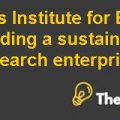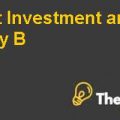The Buyout of AMC Entertainment Case Study Solution
Value Creation Opportunities for JPMP:
There are many value creation opportunities for JPMP while it goes to own AMCE in which first is to view AMCE as the leading company in theater industry by showing more efficiency and professionalism in its operations as compared to its competitors.
In an addition, the other value creation activity for JPMP is the management team of AMCE,which is considered the highly reputed and efficient as compared to the competitors. The AMCE management team consists of the huge quantity of continuous innovator employees, which improves the products and services at a level where the competitors cannot reach. In short, investing 250 million dollars in the acquisition and merger with AMCE will lead to capture the position of being the second largest movie and theater chain in the United States.
Due to the recession in the market, JPMP is unable to recognize the true market value of the AMCE. To consider this, the ideal point in order to find the ideal candidate for leveraged buyout is the skilled, knowledgeable and well trained management team of AMCE, which might lead to the great success for the company in its future by driving the revenue growth and growing cost efficiency.
Primary Risks for Leveraged Buyout:
Theater and movie industry’s current performance is not up to the mark as compared to the expected one, while many of the competitors in the industry have been filed for bankruptcy,which is considered the high potential risk for this acquisition and merger.
There are too many ups and downs in the industry because of which the investors resist to invest in it. Apart from it, Apollo has the major investment in AMCE, which might create problems during the completion of transaction. Apollo is the major shareholder of AMCE, which might demand the equal returns as the JPMP earns. In short, Apollo’s ownership in AMCE might create difficulties for AMCE leveraged buyout by JPMP.
Currently, AMCE is undervalued in the market due to the recession period, while by using the discounted cash flow (DCF) method by JPMP and its experts, its per share value found 25 dollar which is 9 dollar greater than the market value of share. The higher value through using DCF model shows that the JPMP is purchasing the shares of AMCE at lower priced, which will provide the benefit to it in the future when the recession period will end.
Valuation Analysis and Per Dollar Share Price:
Apollo has the major investment in AMCE, which might create problems during the completion of transaction. Apollo is the major shareholder of AMCE, which demands the return equal to 20 to 25 percent as the JPMP earns. The involvement of Apollo in the transaction process of acquiring and merging is beneficial for JPMG because the total funds will further proceed with the deal.
Exhibit 2 shows that the offered price must be between 16 to 25 dollar per share, because the per unit share price according to discounted cash flow (DCF) method is 25 dollar, while in the market it is currently trading on 16 dollar per share. That means JPMP can offer the share price anywhere from 16 to 25 dollar, because currently share price in the US market is undervalued, which creates the large difference between the market value of AMCE share and the calculated value. The return of 20 to 25 percent could be maintained in the given range of the share price.
Conclusion:
In conclusion, AMCE is looking an attractive strategic buyout option. Although its market value is undervalued due to the recession period in the market but the calculated price of AMCE per share is greater than the market price with the difference of 9 dollar per share. So, it is the right time to invest in AMCE.
For the purpose of becoming the second largest Theater and Movie Company in the US industry, JPMP should purchase the AMCE shares in order to grab the great opportunity through undervaluation of AMCE share price due to the recession period in the market, where many of the competitors of JPMP have filed the bankruptcy according to the chapter 13 and 11 of the US law. Therefore, AMCE is growing day by day since its inception, which is considered the great deal that provides benefits in the future.
Exhibit 1: WACC
| WACC | |
| Tax rate | 41% |
| Risk free rate | 4.5% |
| Market return | 12% |
| Risk premium | 7.5% |
| Equity beta | 1.15 |
| Cost of Equity | 13% |
| MV of share | 16 |
| No of shares | 34,000,000 |
| MV of Equity | 544,000,000 |
| Cost of Debt | 8.0% |
| MV of debt | 596,540 |
| WACC | 13.1% |
Exhibit 2: Price of AMCE Per Share
| PRICE OF AMCE PER SHARE | ||||||
| 2005 | 2006 | 2007 | 2008 | 2009 | ||
| NOPAT | 77,385 | 79,812 | 89,043 | 99,936 | 111,221 | |
| Add: | ||||||
| Deprecation and amortization | 132,046 | 139,969 | 148,367 | 157,269 | 166,705 | |
| Less: | ||||||
| CAPEX | 70,000 | 70,000 | 70,000 | 70,000 | 70,000 | |
| Increase in working capital | 3,143 | 4,212 | 3,932 | 3,631 | 3,765 | |
| Total free cash flow to capital | 136,288 | 145,569 | 163,478 | 183,574 | 204,161 | |
| Less: Interest expenses | (95,033) | (95,033) | (95,033) | (95,033) | (95,033) | |
| Free cash flow to equity | 41,255 | 50,536 | 68,445 | 88,541 | 109,128 | |
| Discount rate | 13.1% | 13.1% | 13.1% | 13.1% | 13.1% | |
| PV of Free Cash Flows | 36,471 | 39,496 | 47,290 | 54,082 | 58,928 | |
| Growth | 3.3% | |||||
| Terminal Value | 616,704 | |||||
| Value of AMCE | 852,971 | |||||
| Total No of Shares | 34,000 | |||||
| Per Share Value | 25 | |||||













